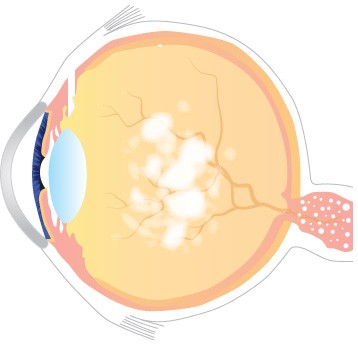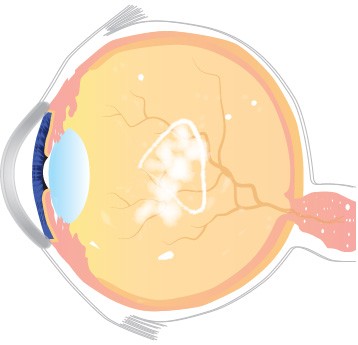Vitreolysis Laser Treatment of Floaters
This series of questions and answers will help you to understand the origin of floaters as well as the different types.
This series of questions and answers will help you to understand the origin of floaters as well as the different types.
The vitreous humor is the clear, jelly-like substance in the main chamber of the eye, located between the lens and the retina.
At a young age, the vitreous is perfectly transparent. Over time as the eye ages, this vitreous humor can degenerate, losing its form and liquefying. Without the stable vitreous humor, the collagen fibers collapse and bind together to form clumps and knots. It is these fibers, which cast shadows on the retina and appear as spots, strings, or cobwebs that are commonly referred to as “eye floaters.”
In many cases as the eye ages further, the vitreous humor can peel away from the retina entirely. This is known as Posterior Vitreous Detachment (PVD). PVD is often associated with a sudden increase in the number of floaters.
Eye floaters are small pieces of debris that float in the eye’s vitreous humor. This debris casts shadows onto the retina (the light-sensitive tissue layer at the back of the eye). If you have eye floaters, it is these shadows that you see “floating” across your field of vision.

Most common in young people, this thin, dense floater can appear as multiple dots and/or string-like cobwebs and is a result of clumping of the collagen fibers of the vitreous. Depending on size, and where it is located, it may be treatable with vitreolysis.

This cloud-like floater is caused by the natural aging process. Whilst this type of floater can sometimes be treated with vitreolysis, it often requires more overall treatment in order to obtain satisfactory results.

The ring-shaped Weiss Ring floater is a large, fibrous floater that is usually located safely away from the crystalline lens and the retina. Because of this, it can be treated safely and effectively with vitreolysis.
Also known as floater laser treatment, vitreolysis is a non-invasive, pain-free procedure that can eliminate the visual disturbance caused by floaters. The goal of vitreolysis is to achieve a “functional improvement”. That is, to allow you to return to “normal” day-to-day activities without the hindrance of floaters.
Vitreolysis involves the application of nanosecond pulses of laser light to evaporate the vitreous opacities and to cut the vitreous strands. During this process, the floater’s collagen and hyaluronin molecules are converted into a gas. The end result is that the floater is removed and/or reduced to a size that no longer impedes vision.
Vitreolysis is performed as an outpatient procedure; you do not have to stay overnight in a hospital. Immediately prior to treatment, you will have anaesthetic eye drops administered.
A contact lens will then be placed on your eye, with the laser light delivered through a specially designed microscope.
During your vitreolysis treatment, you will likely observe small, dark specks/shadows – signaling that the floaters are being evaporated into small gas bubbles. These gas bubbles quickly dissolve and resorb into the vitreous.
Once the treatment is complete, your ophthalmologist may treat your eyes with anti-inflammatory drops.
Each treatment session typically takes 20-60 minutes to perform and most patients will need to undergo two treatment sessions, sometimes three, in order to achieve a satisfactory result.
You may observe small, dark specks in your lower field of vision immediately following treatment, which are gas bubbles and will quickly dissolve. It is also important to note that some patients may experience mild discomfort, redness or temporarily blurred vision directly following treatment.
Reported side effects and complications associated with vitreolysis are rare. Side effects may include cataract and intraocular pressure (IOP) spike.
It is necessary to undergo an ophthalmic examination to determine your eligibility for vitreolysis treatment.
Clinical studies have shown vitreolysis to be a safe, effective treatment in the majority of patients. If floaters persist, however, your ophthalmologist may recommend a surgical vitrectomy.
Depending on your diagnosis, there are several forms of surgery available. Performed in the operating room, surgery involves removal of all or part of the vitreous humor and the accompanying floaters. This type of surgery is very effective but more invasive and has its own risks which are rare but include bleeding, infection and cataract.
I understand that all my data, clinical and otherwise will be protected under GDPR. I understand my data may used for the purposes of quality improvement and advancement of eye care such as audit. This is a component of good clinical governance and measures will be taken to ensure my data is not identifiable.
